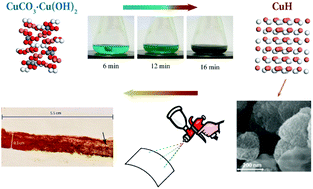Synthesis of copper hydride (CuH) from CuCO3·Cu(OH)2 – a path to electrically conductive thin films of Cu†
Abstract
The most common synthesis methods for copper hydride (CuH) employ hard ligands that lead to the formation of considerable amounts of metallic Cu as side-product. Here we explore a synthesis method for CuH(s) through the reaction of CuCO3·Cu(OH)2(s) with hypophosphorous acid (H3PO2) in solution, via the formation of the intermediate Cu(H2PO2)2(aq) complex. The reaction products were characterized with XRD, FTIR and SEM at different reaction times, and the kinetics of the transformation of Cu(H2PO2)2(aq) to CuH(s) were followed with NMR and are discussed. We show that our synthesis method provides a simple way for obtaining large amounts of CuH(s) even when the synthesis is performed in air. Compared to the classic Würtz method, where CuSO4 is used as an initial source of Cu2+, our synthesis produces CuH particles with less metallic Cu side-product. We attribute this to the fact that our reaction medium is free from the hard SO42− ligand that can disproportionate Cu(I). We discuss a mechanism for the reaction based on the known reactivity of the reagents and intermediates involved. We explored the possibility of using CuH(s) for making electrically conductive films. Tests that employed water-dispersed CuH particles show that this compound can be reduced with H3PO2 leading to electrically conductive thin films of Cu. These films were made on regular office paper and were found to be Ohmic conductors even after several weeks of exposure to ambient conditions. The fact that the synthesis reported here produces large amounts of CuH particles in aqueous media, with very little impurities, and the fact that these can then be converted to a stable electrically conductive film can open up new applications for CuH such as for printing electrically conductive films or manufacturing surface coatings.



 Please wait while we load your content...
Please wait while we load your content...